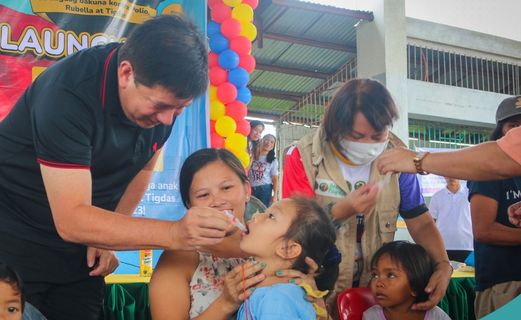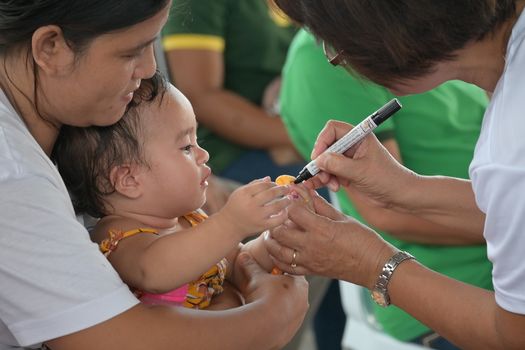Story: ELMER RECUERDO
Photos: DOH 7/Elmer Recuerdo
Photos: DOH 7/Elmer Recuerdo

TACLOBAN CITY – The scorching heat of the mid-morning sun failed to dampen the spirit of 64-year-old Lola Cresencia while carrying her 11-months old grandson in her arms as she joined the queue in a health center in the northern district of this city.
When the attending nurse saw her, Lola Cresencia was immediately told to come to the front and limply approached the nurse to explain her circumstance.
"I just came home from Dolores and found that my grandson is already past due his immunization schedule," she explains as she hands a booklet of the child's health records.
The nurse explains to her that the child's vaccination, which is for Measles, Mumps and Rubella (MMR) – administered for children from nine months to one-year-old – is still within the prescribed date.
"I keep a close track of the vaccination of my three grandchildren to make sure that they do not miss even a single shot," she said. "I do not want them to miss one opportunity that could change their lives."
Since she was in elementary school, Lola Cresencia has been limping with one leg shorter and smaller than the other due to polio, a viral infection she acquired in her third grade.
"I failed to get a polio vaccine because our village was very far from the town center and there were no roads then. I missed the vaccination when it was done in our school," she said.
When the attending nurse saw her, Lola Cresencia was immediately told to come to the front and limply approached the nurse to explain her circumstance.
"I just came home from Dolores and found that my grandson is already past due his immunization schedule," she explains as she hands a booklet of the child's health records.
The nurse explains to her that the child's vaccination, which is for Measles, Mumps and Rubella (MMR) – administered for children from nine months to one-year-old – is still within the prescribed date.
"I keep a close track of the vaccination of my three grandchildren to make sure that they do not miss even a single shot," she said. "I do not want them to miss one opportunity that could change their lives."
Since she was in elementary school, Lola Cresencia has been limping with one leg shorter and smaller than the other due to polio, a viral infection she acquired in her third grade.
"I failed to get a polio vaccine because our village was very far from the town center and there were no roads then. I missed the vaccination when it was done in our school," she said.

Polio is a disabling and life-threatening disease caused by poliovirus, one of the dreaded diseases that could have been avoided by immunization.
Lola Cresencia said she missed so many chances in life due to this disease. "I stopped going to school not only because of the difficulty in going to school but also the bullying that I got from my fellow students."
"I could have been a good teacher because I was good in class," she said. "That's why I made sure that my children and grandchildren are fully vaccinated. I also tell my neighbors to bring their children to the health center, anyway it is free."
Lola Cresencia said she missed so many chances in life due to this disease. "I stopped going to school not only because of the difficulty in going to school but also the bullying that I got from my fellow students."
"I could have been a good teacher because I was good in class," she said. "That's why I made sure that my children and grandchildren are fully vaccinated. I also tell my neighbors to bring their children to the health center, anyway it is free."

LAGGING BEHIND:
The World Health Organization (WHO) and the United Nations Children's Fund (Unicef) urge member-states to cover 95 percent of children with routine vaccines. They said vaccines protect children from life-threatening diseases, saving millions of lives each year.
"For routine vaccines to be effective, children need to complete the required doses according to schedule from the time they are born until they are one year old," the Unicef said in a statement.
Routine vaccines include BCG and Hepatitis B to be given at birth; Pentavalent vaccine, which protects against diphtheria, pertussis, tetanus, haemophilus influenzae type b and Hepatitis B, and PVC against pneumonia and meningitis for infants aged six, ten and 14 weeks; Oral Polio Vaccine; and MMR.
UNICEF and the WHO said the Philippines remains among the top five countries with the most number of zero-dose children globally and the greatest contributor to the number of zero-dose children in East Asia and the Pacific Region.
The UN agencies said that despite progress in reducing the number of zero-dose or unvaccinated children between 2021 and 2022 from around 1 million to 637,000 children for those born within 2022, more work needs to be done to reach the ideal 95 per cent coverage, especially for those not reached in previous years.
Eastern Visayas, one of the poorest regions, is among those that lags behind with almost half of the children not getting the required vaccine shots.
The World Health Organization (WHO) and the United Nations Children's Fund (Unicef) urge member-states to cover 95 percent of children with routine vaccines. They said vaccines protect children from life-threatening diseases, saving millions of lives each year.
"For routine vaccines to be effective, children need to complete the required doses according to schedule from the time they are born until they are one year old," the Unicef said in a statement.
Routine vaccines include BCG and Hepatitis B to be given at birth; Pentavalent vaccine, which protects against diphtheria, pertussis, tetanus, haemophilus influenzae type b and Hepatitis B, and PVC against pneumonia and meningitis for infants aged six, ten and 14 weeks; Oral Polio Vaccine; and MMR.
UNICEF and the WHO said the Philippines remains among the top five countries with the most number of zero-dose children globally and the greatest contributor to the number of zero-dose children in East Asia and the Pacific Region.
The UN agencies said that despite progress in reducing the number of zero-dose or unvaccinated children between 2021 and 2022 from around 1 million to 637,000 children for those born within 2022, more work needs to be done to reach the ideal 95 per cent coverage, especially for those not reached in previous years.
Eastern Visayas, one of the poorest regions, is among those that lags behind with almost half of the children not getting the required vaccine shots.

Data from the Department of Health regional office in Eastern Visayas shows that in 2023 only 58,971 out of the 101,728 target population were fully immunized or 57.97 percent immunization coverage.
Among the provinces and independent cities in Eastern Visayas, Biliran recorded the highest immunization coverage of 70.98 percent while Northern Samar recorded the lowest with 49.77 percent.
"Northern Samar has the most number of geographically isolated and disadvantaged areas in the region," explains Chiradee Claridad, program manager of the National Immunization Program in DOH-8.
She said another factor could be slow reporting from the municipalities due to absence of mobile signals in many areas.(CJ/ER)
Among the provinces and independent cities in Eastern Visayas, Biliran recorded the highest immunization coverage of 70.98 percent while Northern Samar recorded the lowest with 49.77 percent.
"Northern Samar has the most number of geographically isolated and disadvantaged areas in the region," explains Chiradee Claridad, program manager of the National Immunization Program in DOH-8.
She said another factor could be slow reporting from the municipalities due to absence of mobile signals in many areas.(CJ/ER)



















